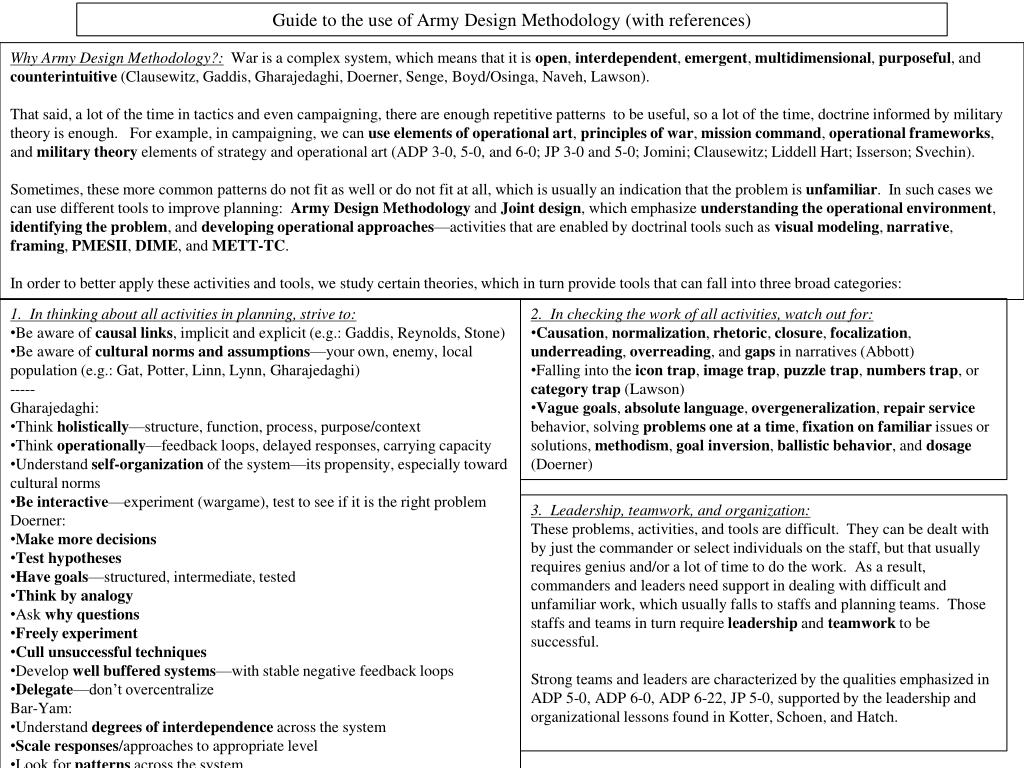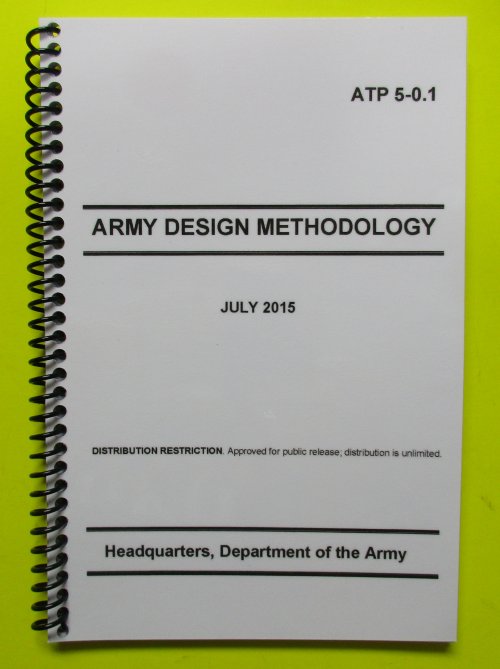Table Of Content

Framing the problem identifies obstacles impeding progress toward the commander’s desired end state. Framing activities help leaders frame a problem including reviewing the environmental frame, identifying problems and mapping out their relationships, and using a narrative and graphics to capture the problem frame (Department of the Army, 2015). The purpose of problem framing is to determine which obstacles are impeding the end state.
An Irregular Upgrade to Operational Design - War On The Rocks
An Irregular Upgrade to Operational Design.
Posted: Fri, 19 Mar 2021 07:00:00 GMT [source]
Using the Army Design Methodology Process to Frame Problems

Mind mapping begins with a single variable and ends after the planning team identifies all secondary variables and their relationships (Department of the Army, 2015). Also, mind mapping works well as a visual aid through symbols, lines, diagrams, and pictures representing relationships. While using the visual aid, planning teams can continue understanding the situation through more detailed meta-questioning and questioning assumptions. Lastly, the group uses four ways of seeing to understand how relevant actors view others, view themselves, and how actors view each other. Fortunately, as previously stated, the CSM, or SGM, acts on behalf of the commander at times to enable understanding among staff members and planners.
Army Design Methodology: Operational Art in Combat

Commanders and staff members cannot frame a problem if a problem statement is too vague, narrow in definition, or contains presumed solutions. To avoid poorly framing a problem, a practical approach would include an open discussion by a commander and their staff using the problem framing tools and techniques. Questioning assumptions and brainstorming effectively identifies obstacles and frames the problem. This work addresses a void in the literature discussing the use of Design Methodology to understand contemporary conflict that often manifests as small wars. Much of the existing work on the topic focuses on various ways to employ the methodology and rarely present examples of successful use.
The Army Design Methodology: Enhancing Decision-Making in a Complex World
Inputs from disparate individuals vis-à-vis agencies are sought and deliberated upon, to ‘arrive’ at the most optimum decision outcome. More precisely, the military decision-making process relies on analyses, inputs and recommendations from various staff echelons, made under the overarching objective of assisting and lending clarity to the commander’s intent. The commander and staff normally work in a group/collective environment to plan, synchronise and control/ guide various small and large scale operations. The assumption underpinning the entire process is that inputs from all agencies/ individuals/are unbiased and attuned to ensure the meeting of command objectives in the best possible way. While such a rubric of decision-making model seems, and in most junctures, is, ‘fool-proof,’ with oversight mechanisms at every level, it is not without its underlying vulnerabilities and ‘pressure points’. The paper attempts to uncover a few such psychological pressure points and vulnerabilities which currently prevail in the decision making paradigm.
According to the Department of the Army (2015), “brainstorming helps the team develop ideas and variables for further research and analysis” (p. 3-6). To properly frame the problem, leaders must identify obstacles, and brainstorming is a technique that facilitates the ADM framework. Brainstorming in an organization’s public area, such as a multi-purpose room, will promote a shared understanding amongst the staff framing the problem.
These ideas allowed the design team to look at many past operations in Afghanistan and develop better ways of executing them with a plan to sustain the progress and momentum. Depending on the size of the team, members potentially had as many as five specific categories that required in-depth research to understand the complexity of the subject matter. Tactical and policy-level decision-making in the armed forces and larger government institutions adheres to a collaborative paradigm.
“A decisive point is a geographic place, specific key event, critical factor, or function that, when acted upon, allows CDRs to gain a marked advantage over an adversary or contribute materially to achieving success” (JCS, 2020, p. IV-32). An example of a decisive point is Ukraine’s successful disruption of the Russian military’s logistics which caused the Russians to abandon their vehicles due to a lack of fuel supplies (Davydenko et al., 2022). The analysis used in identifying a COG with its critical requirements and vulnerabilities, which also helps determine a decisive point, indicates systems thinking. Collaboration and dialogue occur between more than two people or organizations and build a mutual understanding of the OE, resulting in a unity of effort.
These activities help ensure that the operational approach is feasible for further detailed planning development. Reviewing the environmental and problem frames before developing an operational approach is critical in ensuring that the data collected is still applicable and current. For instance, staff must review whether conditions in the OE are still the same whenever operations start, to ensure that desired effects are still achievable.
This is a more strategic method of planning that appears to be a true form of art, coincidentally, it is known as Art of Design or Operational Art. According to the Department of the Army (2015), the planning team must assist the commander in understanding the operational variables, relevant actors, physical environment, and how each interacts with the other. Systems thinking is a key concept in which a series of interrelated components interact within the system.
Soldiers attending the Sergeants Major Academy (SGM-A) use practical exercises in a small group setting to help develop graphics and narratives depicting framing a problem to prepare for future positions as senior enlisted advisors. In addition to practical exercises, Soldiers attending the SGM-A receive instructions on ADM concepts such as operational art and systems thinking to help reinforce framing problems and framing activities. As the senior enlisted advisor within a financial management organization, the Financial Management SGM is responsible for coordinating and providing fiscal assets to commanders. A significant part of financial management operations revolves around managing budgetary resources within the OE, often involving data analytics (Department of the Army, 2014). A Financial Management SGM can facilitate framing the problem in an organization using regression models and predictive analysis when reviewing data.
Soldiers and key leaders of the 3rd Brigade Combat Team, 1st Infantry Division are actively applying Operational Art and current Army Doctrine to assist in the planning of military operations. Since long before the initial invasion into Afghanistan Oct. 19, 2001, US troops have relied heavily upon the Military Decision Making Process for planning combat operations. While many people are comfortable with the status quo, change is inevitable and necessary, even more so in extended operations in a counterinsurgency environment.
“The SGM is key in the training and operations planning process, leveraging their experience and vast technical and tactical knowledge to advise the staff and the Operations Officer” (Department of the Army, 2020, p. 2-5). With an understanding of the ADM process, key concepts, and activities, the SGM can expertly facilitate framing a solution in an organization through working groups. For instance, the SGM works within working groups to develop solutions to organizational problems. SGM collaborating with the staff enables observation of their creative and critical thinking and may provide coaching when needed.
According to the Department of the Army (2020), “the SGM is key in the training and operations planning process, leveraging their experience and vast technical and tactical knowledge to advise the staff” (p. 2-5). With so much influence and knowledge, SGMs can facilitate framing the problem in organizations. Operations SGMs and Financial Management SGMs have the platform to facilitate the ADM process in organizations.
LTC Moore did not achieve the desired end state because the overall framing of the OE suffered. LTC Moore did not use a written narrative in framing steps and instead relied solely on verbal commands. While LTC Moore and his battalion inflicted hundreds of casualties on the NVA, the American forces also suffered heavy losses.
Historically, commanders (CDRs) and staff manage complex situations within an operational environment (OE) that continuously changes. Army design methodology (ADM) provides an approach to dealing with unfamiliar and complex problems. “ADM is a methodology for applying critical and creative thinking to understand, visualize, and describe problems and approaches to solving them” (Department of the Army [DA], 2019, p. 2-16). An example of a complex situation that needs a solution is Ellyatt’s (2022) report on Russian forces invading Ukraine to demilitarize the country. The situation is extraordinarily complex and requires unique solutions to alleviate the suffering of Ukrainian citizens and help keep their sovereignty.

No comments:
Post a Comment